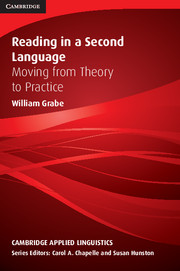Book contents
- Frontmatter
- Contents
- Series editors' preface
- Preface
- I FOUNDATIONS OF READING
- II PATTERNS OF VARIATION IN READING
- III DEVELOPING READING COMPREHENSION ABILITIES
- Chapter 10 Building main-idea comprehension
- Chapter 11 Becoming a strategic reader
- Chapter 12 Building awareness of discourse structure
- Chapter 13 Vocabulary and reading comprehension
- IV EXPANDING READING COMPREHENSION SKILLS
- References
- Author Index
- Subject Index
Chapter 10 - Building main-idea comprehension
from III - DEVELOPING READING COMPREHENSION ABILITIES
Published online by Cambridge University Press: 05 August 2012
- Frontmatter
- Contents
- Series editors' preface
- Preface
- I FOUNDATIONS OF READING
- II PATTERNS OF VARIATION IN READING
- III DEVELOPING READING COMPREHENSION ABILITIES
- Chapter 10 Building main-idea comprehension
- Chapter 11 Becoming a strategic reader
- Chapter 12 Building awareness of discourse structure
- Chapter 13 Vocabulary and reading comprehension
- IV EXPANDING READING COMPREHENSION SKILLS
- References
- Author Index
- Subject Index
Summary
There has been a great deal of research on how to promote reading comprehension but not much on how well this knowledge has filtered into the classroom. Teachers seem not to teach comprehension instruction strategies without having themselves been prepared to teach them.
(Trabasso & Bouchard, 2002: 186)Comprehending a text, or main-idea comprehension, requires the ability to identify main ideas in the text, integrate them into a text model of reading, and develop an appropriate situation model of reader interpretation (see Chapters 2 and 3).Main-idea comprehension also involves a reasonable knowledge of basic grammar, effective comprehension strategies to use with more difficult texts, strategic processing abilities to maintain a high level of comprehension for extended periods of time, an awareness of discourse structure, and a large receptive vocabulary-knowledge base (Pressley, 2002a). In this chapter, the roles of grammar knowledge and comprehension strategies are examined as resources for main-idea comprehension. Together, they provide two of the foundations for assembling text comprehension. Chapters 11, 12, and 13 expand upon this theme, exploring the development of strategic reading, discourse awareness, and vocabulary knowledge.
At one level, it is not possible to directly teach main-idea comprehension. The reader must engage internal cognitive processes and knowledge resources that distill main ideas from the text on the basis of reader goals and task assignments. However, the reader can demonstrate main-idea comprehension on the basis of task outcomes, interactions with others around text information, and various exercises and assessment practices. Moreover, the teacher can “teach comprehension” by establishing an effective learning environment, engaging students directly with the text, and supporting the skills needed to help readers identify main ideas.
- Type
- Chapter
- Information
- Reading in a Second LanguageMoving from Theory to Practice, pp. 198 - 219Publisher: Cambridge University PressPrint publication year: 2008



